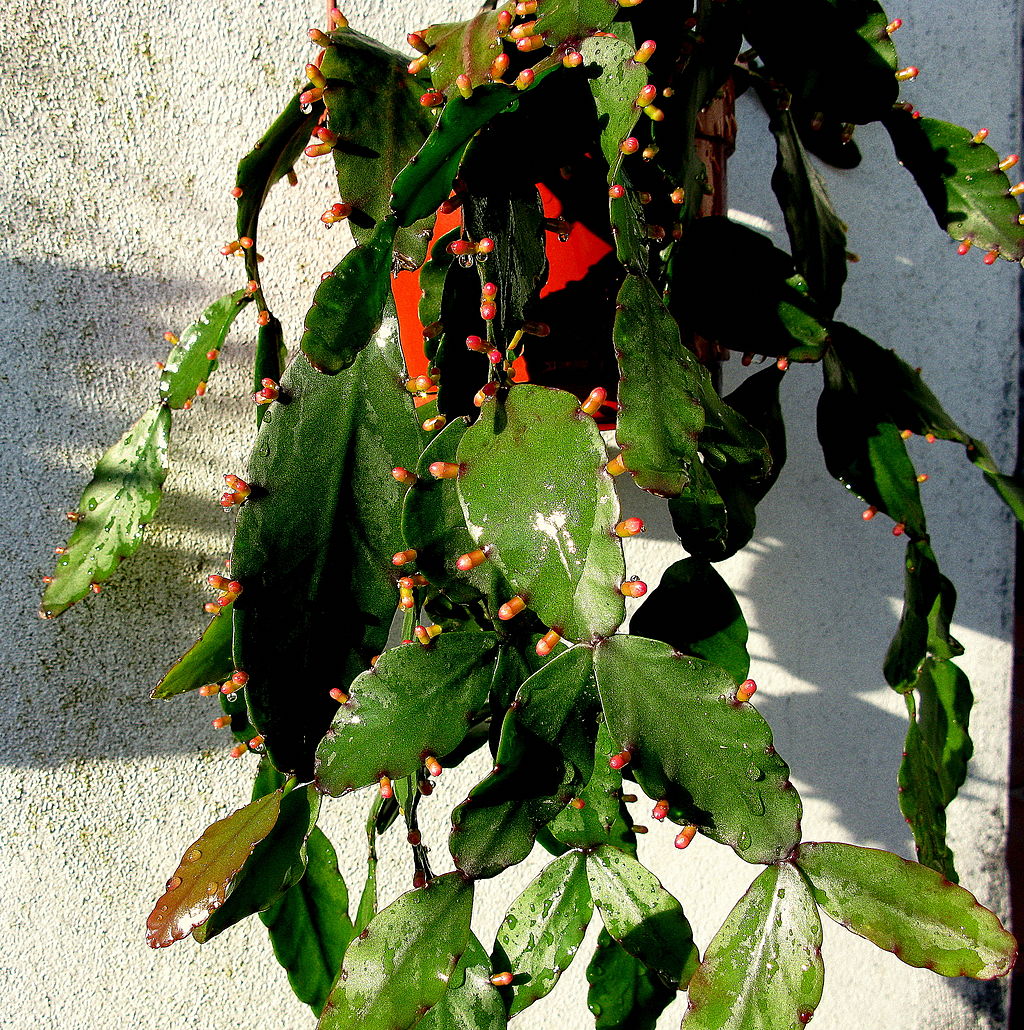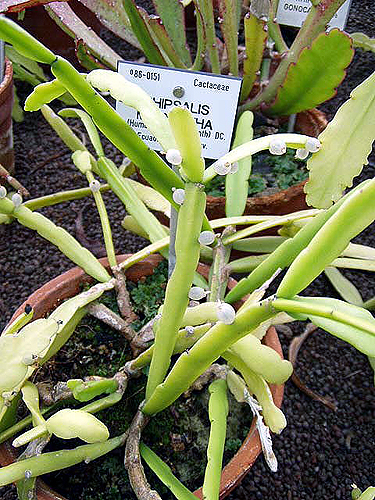When it comes to your leopard gecko terrarium, you can choose a variety of setups to meet your needs. Many leopard gecko owners choose a bioactive setup, which includes live plants and soil, creating a natural desert environment to meet your gecko’s needs.
There is a great selection of live plants for you to use in your leopard gecko enclosure. Remember when making your selection you choose safe plants that are desert species, enabling them to manage the high desert temperatures.

Best Safe Live Plants for a Leopard Gecko Terrarium
Christmas Cactus

Christmas Cactus, also known as Schlumbergera, is a long-lasting plant that can last for many years. It can be planted in a larger enclosure with excellent drainage and good quality soil.
This is a good choice for leopard geckos in a tropical enclosure that isn’t too wet, allowing the cactus to dry out from time to time. Ideally, the plant needs to be planted in the background. If planting in soil, ensure it is very well-drained soil. This cactus grows scaly with long leaves.
Senecio Radicans – String of Bananas

The String of Bananas is a succulent plant that comes from the Cape Province in Southern Africa. It is drought tolerant and closely related to the String of Pearls plant.
The plant has small tendril leaves that are in the shape of a banana and a vine that grows up to three feet in length, making it suitable for a larger enclosure. The plant prefers well-drained soil and it doesn’t need bright lighting. It is low maintenance and easy to care for.
The plant is suitable for container gardens and well-drained terrariums, due to its small foliage size. Please note, this plant may need to be pruned to keep the growth under control.
Senecio Rowleyanus – String of Pearls

Senecio Rowleyanus, the String of Pearls is a succulent plant that is native to South Africa. It is drought tolerant and comprises of numerous pearl-shaped leaves. This is a vine growing plant that can grow up to two feet in length. It spreads quickly, making a great ground cover.
This plant thrives in well-drained soil with indirect, yet bright light. It can tolerate both partial shade and full sun.
The String of Pearls is low maintenance and easy to care for. Being a succulent, it is suitable for the leopard gecko enclosure that has lower humidity levels of no more than forty percent.
Rhipsalis cf. Elliptica

The Rhipsalis cf. Elliptica is a smooth flat-leaved plant that has red fruit and yellow flowers. It is a compact plant, growing to approximately eighteen inches. It enjoys an indirect and bright light with well-drained soil, making it a great addition to large enclosures.
The soil in the bioactive enclosure should be kept moist, but the roots must not be allowed to sit in water for extended periods, as this can lead to root rot.
The plant grows to approximately two inches in length, but it can grow more than one and a half feet in width, which means you may need to uproot the plant if it grows too big for the enclosure, possibly moving it to your home garden.
Hoya Carnosa f. Compacta ‘Krinkle Kurl’ – Hindu Rope Plant

The Hindu Rope Plant, better known as the Krinkle Kurl, is a unique plant that has curly leaves that are thick with non-climbing vines in green. The vine thickness with waxy leaves makes this a popular plant in the leopard gecko enclosure.
Native to Southern India, the plant is a member of the Milkweed family with star-shaped flowers.
This plant requires well-drained soil with almost dry soil conditions.
It is a slow-growing plant, taking years to develop its flowers, which makes it suitable for larger enclosures as the vines can grow up to two inches wide, they can grow up to twenty feet in length, though it will take many years to get to this point.
Euphorbia milii ‘Dwarf Apache’ – Crown of Thorns

The Dwarf Apache or Crown of thorns is a succulent plant that requires the same habitat as cacti, making it an ideal choice for the desert enclosure design of your leopard gecko.
The plant has a thorny stem that has side branches, which develop near the soil line. They have broadleaf evergreen foliage. This plant can grow very big and will have seasonal flowers in a beautiful pink and red color. The plant enjoys drier conditions.
Due to the size, you need to ensure you only use this plant in a large terrarium with the possibility of having to transplant it to your garden at a later stage.
Hoya cf. Panchoi

This is also known as the Wax Plant. It promotes beautiful thick leaves of green, which develop a dark pink color over time.
The pink and yellow flowers are small but bursting with fragrance. The Hoya cf Panchoi is native to Asia and is a popular houseplant, offering a unique appearance and being easy to care for.
This is a succulent, which means it prefers well-drained soil and shouldn’t be allowed to sit in a wet environment for extended periods, making it ideal for leopard gecko enclosures. It needs bright light.
It is recommended the plant is washed thoroughly before placing it in the terrarium.
Kalanchoe Synsepala – Walking Kalanchoe

The Walking Kalanchoe is a succulent that has flat leaves and a serrated edge with a red coloration. This plant is a member of the Crassulaceae family native to South Africa.
This plant has long stems that produce new plants on the end, hence the name Walking Kalanchoe.
This plant thrives in bright and indirect light with dry soil. It can be grown as a houseplant and does exceptionally well in hanging baskets.
If you choose to add it to the enclosure, you will need well-drained soil and remove the plant and replant it at home should it start outgrowing the enclosure.
Rhipsalis Micrantha f. Rauhiorum

This Rhipsalis Micrantha f. Rauhiorum plant is a rare terrestrial plant found in limited areas of Ecuador. It produces small white flowers on the segmented stems.
These plants can grow full and up to three inches in length, enjoying bright and indirect light with drained soil. The soil should be moist, but the plant mustn’t be allowed to sit in the water, as it will rot.
While the plant enjoys humidity, it can manage normal household temperatures and humidity with ease.
Rhipsalis sp. ex Hans Weiler

This is a smooth plant with flat stems that hang down, twisting slighting throughout the stem. The plant grows to around three inches and is stunning in a hanging basket. It prefers bright and indirect light with well-drained soil.
It is suitable for a larger enclosure with moist to dry soil and plenty of light. While it only grows to three inches, the plant does grow wide, so bear this in mind when choosing where to place it in the enclosure.
Lepismium Cruciforme var. Spiralis – Hurricane Cactus

Lepismium Cruciforme var. Spiralis, or Rhipsalis Cruciformis and Trailing Cactus is a plant native to Argentina, Brazil, and Paraguay. It is often found growing in trees in humid conditions.
The leaves grow in a spiral with small white flowers that are fuzzy in appearance. This plant does well in well-drained soil with indirect light. The soil should be moist, but not allowing the roots to sit in water and rot.
This plant is suitable for larger enclosures that can accommodate the three inches height and the two foot width.
Rhipsalis sp. ex Craig Allen

The Rhipsalis sp. Ex Craig Allen is a smooth and tubular step branching out and hanging down.
The stems are thin, yet the plant is full and thick that can grow to two inches in length, enjoying indirect light and well-drained soil.
The soil should be kept moist, but the roots must not be allowed to sit in water for extended hours as this can result in rot.
This plant is suitable for a large enclosure, possibly having to be replanted in the home garden at a later stage, due to the wide growth that develops.
Conclusion
A bioactive enclosure is a top choice for many leopard gecko owners. This type of design has the enclosure looking after itself, cleaning itself. It mimics the natural environment.
Live plants are an essential part of any bioactive enclosure. Remember to choose the plants with care, basing your decision on growth speed, size, and what is safe for your leopard gecko in the long run.